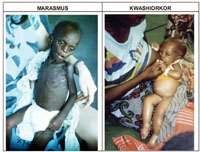6.3 Classification of malnutrition
You need to know how to identify acute malnutrition, and to differentiate between severe acute malnutrition and moderate acute malnutrition.
In the past, severe acute malnutrition was classified in the way described in Box 6.1 and Figures 6.3 and 6.4 overleaf. You need to know this, because you may come across people who still use these terms.
Box 6.1 Previous classifications of severe acute malnutrition
Protein-energy-malnutrition (PEM): A clinical syndrome present in infants and children as a result of deficient intake and/or utilisation of food.
Marasmus: Severe form of acute malnutrition that is characterised by wasting of body tissues. Marasmic children are extremely thin. (Figure 6.3)
Kwashiorkor: Severe form of acute malnutrition characterised by bilateral oedema and weight-for-height of greater or equal to -2 SD (Figure 6.4)
Marasmic-Kwashiorkor: Severe form of acute malnutrition characterised by bilateral oedema and weight-for-height of less than -2 SD.
However there is now a new way of classifying malnutrition so you need to know and should use these terms. With the current classification, all the three forms of severe protein energy malnutrition are now classified as severe acute malnutrition.
6.2 Common forms of malnutrition in Ethiopia

